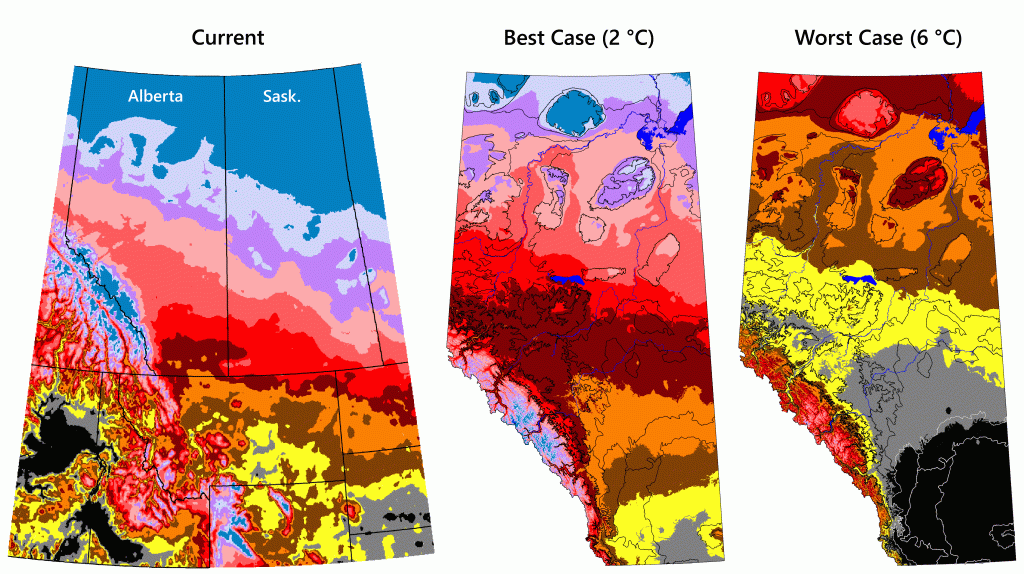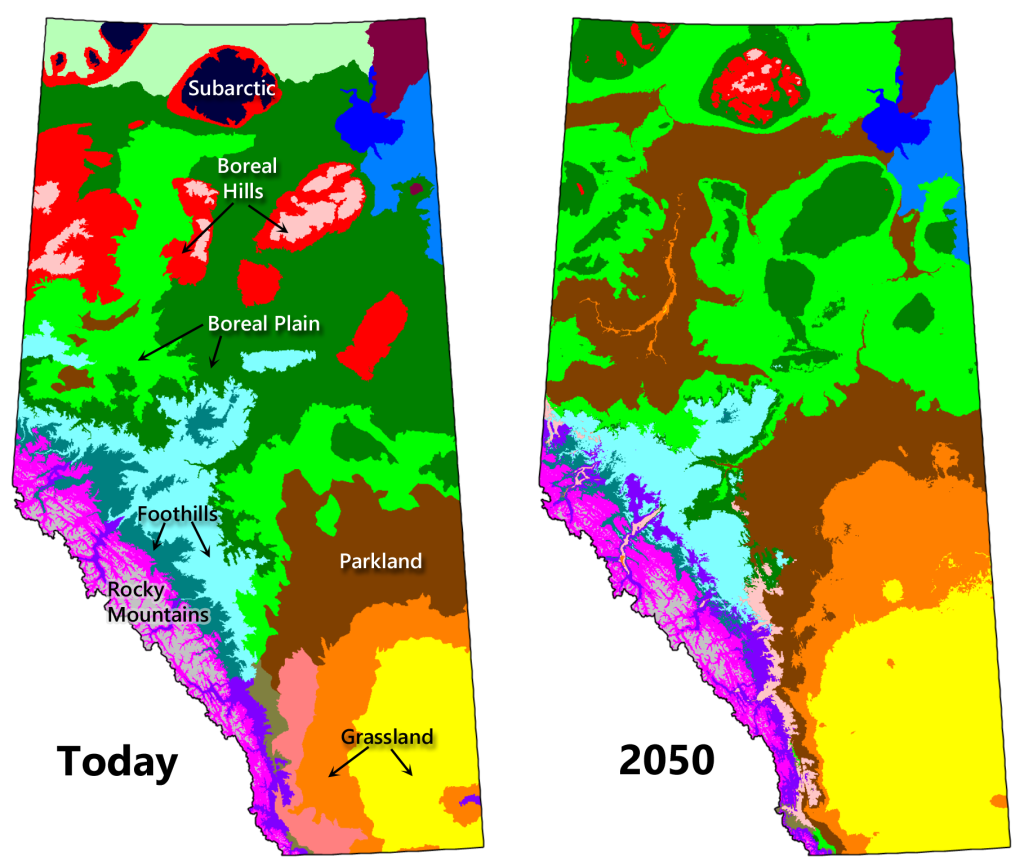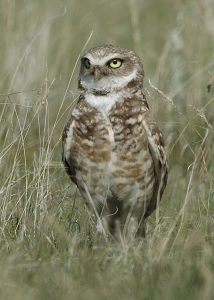Life in a Warmer World

Time Travelling into Alberta's Future
By Richard Schneider
By now, we all know that our climate is warming and will continue to warm until we manage to rein in our emissions of greenhouse gases. We have also heard about the many ways that climate warming will impact our lives — droughts, increased wildfires, rising sea levels, and so forth. But what’s in store for all the other species that share our planet? Is it bad news all around? For naturalists and conservationists, these are questions worth asking.
As one might expect, there is no simple answer. Each ecosystem and species will respond to climate change in its own way. Furthermore, the rate of change and the total amount of warming will make a big difference. Let’s travel forward into the future of Alberta for a glimpse of the ecological changes expected under both a best-case and a worst-case warming scenario.
How Warm Is It Going to Get?
The basic principle underlying global warming is well understood — increased carbon dioxide (CO2) and other greenhouse gases in the atmosphere act like a blanket, trapping more of the sun’s heat at the earth’s surface. You can demonstrate this at home with a jar, thermometer, and some dry ice. But making predictions at the global scale is challenging because there are many feedback loops that have to be accounted for. For example, the progressive melting of the Arctic sea ice turns a white surface that reflects sunlight into a dark surface that absorbs sunlight, speeding the rate of warming. Climate researchers around the world have been grappling with these complexities for decades, building ever more sophisticated climate models. None of these models can be considered fully reliable, however, collectively they provide useful guidance on what we can expect at different levels of greenhouse gas.
The largest uncertainty does not involve the physics of the process, it is estimating how much more CO2 human society will emit in coming years. Social and political processes are in play and the outcomes are difficult to anticipate. Therefore, climate scientists generate their climate predictions across a range of potential emission pathways, from the best case to the worst.
In Alberta, the best-case scenario translates into a rise of roughly 2 °C in the average annual temperature by the end of this century.1 This may not seem like much, but bear in mind that the difference in average temperature between the dry grasslands around Calgary and the parkland ecosystem around Edmonton is just 2 °C. Another 2 °C puts you deep into the boreal forest around Fort McMurray.
It is harder to predict outcomes under the worst-case scenario. There is more potential for surprise when greenhouse gas levels are so much greater than in the recent past. For Alberta, a rise of 6 °C in average annual temperature seems likely under this scenario, and some models suggest the rise could even be higher.1
Figure 1 (above) illustrates Alberta’s predicted temperature zones under the best-case and worst-case scenarios, compared to the current zones. In the best case, temperatures in southern Alberta will resemble those currently found in southern Montana. Much of the boreal region will experience temperatures now found in central Alberta. Under the worst-case scenario, southern Alberta will experience temperatures similar to the hottest parts of Idaho. And temperatures at the Northwest Territories border will be similar to those now found in Lethbridge.
Ecological Responses
Scientists have developed sophisticated models to predict how ecosystems and species will respond to warming temperatures.2 However, the basic patterns of change are easy enough to predict without a computer model. If you want to characterize the biodiversity likely to be found in a given location when average temperatures are 2 °C warmer, travel south to a similar landscape where that temperature already exists and look around. In a mountainous area, walk down to a lower elevation.
The underlying assumption is that climate is the main driver of broad ecological patterns. This is a well-established ecological principle and it implies that species and ecosystems will shift their distributions in response to long-term climatic change. We have good evidence of this in pollen records from 4,000 years ago, when Canada was 2–3 °C warmer than today (the Hypsithermal Period).3 These pollen records suggest that our grassland, parkland, and boreal zones were all farther north than they are today. We have every reason to expect that the same thing will happen under the current episode of warming, at least under the low to moderate scenarios. The worst-case scenario takes us into uncharted waters and it is harder to be sure of what will happen.
So what are the key predictions about future ecological patterns? To begin, at the national scale, overall species diversity is expected to increase as the climate warms. If you have ever watched a David Attenborough movie, you know that the place to find high levels of biodiversity is in the Amazon rainforest, not in Canada, where only the hardiest species can survive. The general rule is that species diversity increases the closer you get to the equator. Therefore, as the Canadian climate becomes less harsh, and species shift northward, we can expect a boost in species richness at all latitudes.
At the regional scale, the patterns of change will be more complex, as the northward shift in ecosystems is affected by regional topography. Regional precipitation patterns will also play an important role, especially in Alberta where much of the boreal region is near the tipping point between forest and open grassland.4 This is evident in the grasslands that lie along the Peace River in northwestern Alberta (the city of Grande Prairie was not named by accident). These grasslands exist wherever precipitation inputs are insufficient to support a forest.

Figure 2. High Level, Alberta lies along the Peace River and supports a farming community even though it is just 150 km south of the NWT border.
The fact is, precipitation inputs across most of northern Alberta are no higher than in the region between Edmonton and Calgary. The reason the north is mostly forested, whereas the Edmonton-Calgary corridor is not, is because the north is cooler, meaning less evaporation and more retained soil moisture. The Peace River Lowlands are right at the tipping point. Precipitation is the same as the surrounding boreal plain, but the lower elevation of this region results in slightly warmer temperatures — just enough to result in grasslands in some spots.
The implication is that it wouldn’t take much warming to reach the forest/grassland tipping point across a vast area, and this is exactly what is expected to happen. As temperatures rise, a large proportion of the boreal forest is destined to progressively transition to parkland habitat and eventually open grassland. The southern boreal fringe will transition first, followed by lower-elevation areas across the north. The end result will depend on how much warming eventually occurs. Under the best-case scenario, northern Alberta will become a complex mosaic of closed forest, parkland, and open grassland (Figure 3). Under the worst-case scenario, it is likely that only the highest elevation sites, such as the Caribou Mountains, will remain forested.

Figure 3. The current distribution of Alberta’s major ecosystem types (left) and projections of these ecosystems for the 2050s (right) under an intermediate climate change scenario. Note that the actual ecological transitions will lag decades behind these temperature-based predictions. Adapted from Schneider and Bayne 2015.5
As the boreal forest contracts, Alberta’s parkland and grassland regions will expand northward. In southern parts of the province, we can expect new grass species to arrive from the northern U.S. Again, the amount of change will depend on how much warming occurs. Under the best-case scenario, the ecosystems of southern parts of Alberta may eventually resemble those of southern Montana. Uncultivated landscapes would continue to exist as grasslands, but with a different mix of species. Under the worst-case scenario, the high temperatures would cause pronounced drying and significantly reduced levels of soil moisture. This would result in a transition to the sagebrush ecosystems currently found in parts of Idaho and Wyoming. The extent of prairie pothole wetlands would also be greatly diminished.
In the mountains and foothills, moisture limitation is not expected to be an issue, so major ecosystem changes are not expected. Instead, existing ecosystems will progressively shift upslope as temperatures warm. The ecosystems found at the highest elevations are likely to contract because they have limited options for moving any higher.
It should be noted that none of these changes will happen quickly. Ecosystem changes will lag well behind climatic changes, especially where long-lived tree species dominate. Mature trees are quite hardy and able to withstand suboptimal conditions. Think of the coniferous trees planted around farmyards in southern Alberta, far outside their normal range. It is not until trees are killed, typically by fire, that a transition to other species can occur. And this will take considerable time (i.e., decades).
It should also be understood that existing ecosystems will not move as intact units. Figure 2 reflects the distribution of ecosystems far in the future, after all species have equilibrated to the new climatic conditions. However, during the transitional phase, which is likely to last well into the next century, ecosystems are likely to exist as complex hybrids of old and new, as some species race ahead and others lag behind.
In summary, as the climate warms we can expect that some ecosystems will expand and others will contract. But overall, productivity and diversity should increase as our harsh climate moderates. This news is especially positive for grassland species, which account for three-quarters of Alberta’s species at risk. Most of these species are at the northern edge of their range in Canada. A warmer climate will suit them better and will also provide the potential for northward expansion.
Caveats
Implicit in the above description of ecological changes is the assumption that plants and animals are able to shift their ranges in response to changing conditions. We know that all Canadian species have this capacity, otherwise life could not have returned to Canada after it was scraped clean by Ice Age glaciers. But humans have profoundly impacted natural systems over the past century, so caution is warranted. We can’t assume that all natural processes still function normally.
Species at risk are a major concern. These species are struggling just to remain viable under current conditions. Add in the need to withstand increased climate variability, such as droughts and floods, while also shifting their range northwards and climate adaptation seems a bridge too far. These species are unlikely to accommodate climate change without considerable support.

Species at risk, such as the burrowing owl, will struggle to adapt to climatic changes because they have little remaining resilience. Burrowing Owl by Gordon Court
Barriers to movement are another concern. During past episodes of climatic change, species were able to move without restriction, allowing range adjustments to take place. Today we have highways and cities like Canmore along major wildlife travel routes. On the prairies, cultivated agricultural landscapes present a broad barrier to species range shifts. It follows that enhancing landscape connectivity needs to be a major thrust of future conservation efforts.
We also need to consider the rapid rate at which the climate is currently changing, which is much faster than in earlier post-glacial episodes. It is quite possible that some species will lack the capacity to respond quickly enough. Species with low dispersal ability or low rate of reproduction may find themselves left behind in unsuitable environments. Assisted migration, where managers physically move species northward, is being explored as a potential solution. However, it is unlikely we would ever have the capacity to do this for more than a select group of species.
Where Do We Go from Here?
In the final analysis, much will depend on how much warming ultimately occurs. The proportion of species “left behind” may be relatively small under the best-case scenario, assuming that management efforts are made to reduce barriers to movement and actively assist highly vulnerable species. This is good to know, given that a rise of at least 2 °C seems inevitable at this point.
The story is much different for moderate to high levels of warming. Here we move into uncharted territory, and widespread adaptation failure is a real possibility. This is an outcome that must be avoided at all costs through concerted global efforts to rein in our greenhouse gas emissions. The shift in societal attitudes over the last few years, resulting in more examples of meaningful action, is encouraging. However, emissions remain well above the best-case scenario, which means that much more effort is needed. We all need to do our part to make this happen.
References
- Schneider, R.R. 2013. Alberta’s Natural Subregions Under a Changing Climate: Past, Present, and Future. Alberta Biodiversity Monitoring Institute, Edmonton, Alberta.
- Gray, L. and A. Hamann. 2013. Tracking suitable habitat for tree populations under climate change in western North America. Climatic Change 117: 289–303.
- Strong, W. and L. Hills. 2005. Late-glacial and Holocene palaeovegetation zonal reconstruction for central and north-central North America. Journal of Biogeography 32: 1043–1062.
- Hogg, E.H. and P. Bernier. 2005. Climate change impacts on drought-prone forests in western Canada. The Forestry Chronicle 81: 675-682.
- Schneider R.R. and E. Bayne. 2015. Reserve design under climate change: from land facets back to ecosystem representation. PLOS ONE 10(5): e0126918.
Richard Schneider is the Executive Director of Nature Alberta and technical editor of Nature Alberta Magazine. He previously worked as a senior scientist with the Biodiversity Conservation Chair at the University of Alberta, where he investigated the ecological effects of climate change among other topics.
This article originally ran in Nature Alberta Magazine - Summer 2021
